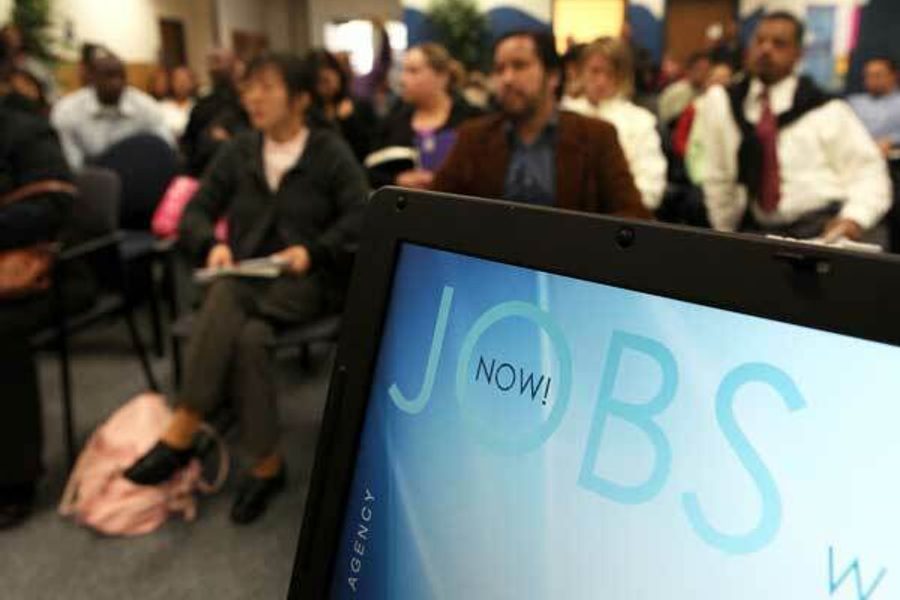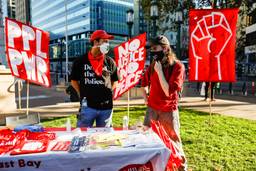How to Create Good Jobs Now
A bold proposal for meeting human needs through a permanent U.S. employment program.
Bill Barclay

This article was written by Ron Baiman, Bill Barclay, Sidney Hollander, Joe Persky, Elce Redmond, Mel Rothenberg.
For the last three decades, U.S. public policy makers have operated on the theory that individual entrepreneurial freedoms are essential to the creation of wealth and thus to the well-being of individuals and society as a whole. One of the great failures this “neo-liberal” approach to economics has been its inability to create enough jobs to keep pace with population growth.
Between 2001 and 2007, the working-age population in the United States outpaced job creation by 10 million individuals. Projections indicate that the shortfall will include another 17 million persons by 2016, making a 16-year total of 27 million missing jobs – 27 million people, in other words, who will have been pushed out of the labor force.
If current trends continue after 2016, labor force participation will have fallen to barely half the working-age population, down from a pre-2000 level of about two-thirds.
The scale of the problem – and program
To confront the growing poverty and social misery that is engulfing the poorest 40 percent of Americans, the United States will require a national jobs program based on significant public investment in the economy. We propose a program that would pay workers the current median wage ($18 per hour), which is a living wage that still allows room for promotions and pay raises. As we will demonstrate, this program can be funded easily by progressive taxes, cuts in defense spending, and taxes on carbon-emitting production.
In the short term, jobs will help people stay in their homes and encourage consumers to begin spending again. In the longer run, a reordering of our economic priorities through public investment and redistribution of access to good jobs will create an economy that serves the needs of all, rather than the wants of a few.
The plan should aim to boost national employment by 3.5 million new jobs each year for five years, for a total of 17.5 million new jobs. This rate of job creation is more than twice the currently projected growth of only 1.5 million jobs per year, which would yield only 7.5 million additional jobs over the five years.
With many more employment opportunities, workers’ bargaining power would increase. Even though the wage would not be enforced as a mandatory economy-wide minimum wage, many workers in private, low-wage jobs would demand higher wages, especially with the program’s $18 per hour minimum serving as a benchmark. It is likely that some low-wage private employers outside of the jobs program (sweatshops come to mind) would not survive the increased labor costs. (Employers could be offered wage subsides to help them survive, but that would increase the cost and dilute the benchmark effects of the program, as employers engaged in a race to the bottom of the wage scale.)
We estimate a resulting loss of roughly 1 million jobs in each of the five years. The 17.5 million jobs the federal government would be permanently supporting after five years includes approximately 5 million positions that would offset private sector employment losses triggered by the jobs program.
We recognize that the current economic downturn may depress private sector job growth below 1.5 million per year, even taking into account federal stimulus spending. In that case, our proposed jobs program might have to be enlarged still further, although we believe that implementation of our program would improve the economic environment by putting money in the pockets of many people who now lack it. This increased demand would stimulate additional growth in private sector jobs.
The work to be done
The jobs program would focus on three broad areas of the economy, with growth concentrated in public enterprises.
First, like the $787 billion stimulus package Congress passed in February, the program would increase investment in public infrastructure, including transportation, educational and healthcare facilities. Other possible spending recipients are parks (local, state and federal), which have long been under-serviced. Infrastructural work would be done by either public agencies or private contractors.
Second, jobs would be created in purely public employment, concentrated principally in health and education. Public employment in these sectors would complement the work on infrastructure, such as the construction of hospitals and schools.
Third, jobs would be created to implement a federal industrial policy that, working closely with the states, would focus on energy and its sources, uses and costs. It is clear that, left to their own devices, major private-sector energy companies have little incentive to shift our energy consumption in a direction that is either more efficient or less costly to the consumer.
As the interstate highway program of the 1950s, the space technology program of the 1960s and 1970s and the government’s development of the Internet indicate, only an entity charged with a public purpose can spark a real shift away from fossil fuels. Energy taxes, while useful for government revenue, are not sufficient. The shift from fossil fuels will require investment in technology, training of workers and temporary wage subsidies, as new energy industries move up the productivity curve.
Though neo-liberal economic ideology holds that government decision-making is inferior to that of private companies when it comes to the markets (in terms of both efficiency and cost), this thinking is contradicted by both American history and policies practiced by many countries today. The governments of China and the Scandinavian countries, for instance, play a major role in spurring their economies’ growth.
In the United States, moreover, we have had a de facto industrial policy for at least the past two decades – namely, the decision to develop the financial sector as both an engine of growth and an export leader. As in the case of the savings and loans crisis of the late 1980s and early 1990s, in which the government spent $125 billion of taxpayer money to liquidate the toxic assets of over 1,000 failed S&Ls, the finance sector is again at the center of a crisis and again drawing massively on the public purse in an attempt to avert economic catastrophe.
Clearly, public money ought to benefit the public, and the only way to ensure this is through the collective decision-making of representative government. The national jobs program we propose would reaffirm this critical government function, helping to reverse the consequences of neoliberal policies.
No such thing as a free job
As explained above, the program would create 3.5 million jobs per year. Assuming a wage of $18 per hour, each job would cost $37,440 annually. At this level, the annual wage and salary cost for each annual cohort of workers entering the program would be about $129 billion.
To that number two additional costs must be added. First are administrative costs, which we estimate at 5 percent of the total program outlays, bringing the incremental cost to $135 billion annually. The second cost arises because supervisory and managerial jobs would receive a higher wage than others (although extreme pay differences executives and other workers would be avoided). This would add another 30 percent cost to the program.
With these two adjustments, the annual cohort cost rises to $175.5 billion. Thus, five years into the jobs program, and continuing permanently thereafter, the jobs program would cost the federal government about $878 billion annually (in 2009 dollars.)
Actually, this cost estimate may be too high. Since many of the participants in the jobs creation program would be youth and the chronically unemployed, an integral part of the proposed jobs program would consist of a major training program. Trainees would be paid somewhere between $12 and $18 per hour. Once they satisfactorily completed the training, they would be guaranteed jobs in the regular program. On the other hand, because training programs would increase administrative costs, we have chosen to err on the high side rather than attempt to estimate net savings that might be realized from the participation of trainees.
Finally, all private employment under the jobs program would be subject to the provisions of the proposed Employee Free Choice Act. These provisions would facilitate the creation of union jobs, where the workers would form trade unions and workers’ associations of their choosing. Work conditions and wage increases would be determined through collective bargaining. All public employees would have the right to bargain collectively, as well.
Funding possibilities
• The ongoing misadventure in Iraq has cost taxpayers approximately $100 billion per year since the 2003 invasion, while the total war budget costs approximately $1 trillion per year. Completing the withdrawal from Iraq and limiting the cost of the war in Afghanistan should free up about half of the $100 billion per year, while another $50 billion could be recouped by trimming the pentagon budget by 5%, for a total savings of $100 billion.
• An excess profits tax on the major energy companies could conservatively raise an additional $50 billion. This tax might be part of a broader “carbon tax” offset by subsidies to low-income households that need to, at least in the short-term, rely on carbon energy sources.
• A half-percent tax on financial transactions would raise significant revenue and have the additional benefit of reducing the volume of highly leveraged financial speculation. When transactions in various derivative markets and the off-exchange bond market are included, the revenues generated, even discounting for the likely reduction in trading, would be sufficient to finance most if not all of our jobs program: A revenue estimate of $600 billion annually for the U.S. seems reasonable.
• If necessary increases in the money supply to accommodate an expanding economy were used to fund jobs rather than pay down federal government debt, additional “tax free” funding of approximately $42 billion would be available.
• Lastly, a wealth tax of 0.5% on the top 1% of households (those with more than $5 million in assets) would generate another $75 billion/year.
The approximately $917 billion generated by these five sources would more than cover the costs of the program, though revenue from some of these sources would not be available until legislation is passed and implemented. Therefore, some financing might have to be borrowed in the short-term – -as has virtually all of the $700 billion allocated toward the current financial bailout.
A properly crafted jobs program must aim at a fundamental restructuring of the labor market. It will, by design, drive up wages for existing low-paying jobs, thus uniting the interests of the chronically unemployed and the working poor. It will mean a significant transfer of income share from the wealthy to the poor. This transfer will necessarily generate opposition, but the conflict will have an upper-versus lower-class dynamic rather than be a racial conflict between different sectors of the lower class.
How do we find the political will?
A near majority of Americans live in households that take in less than $50,000 annually. Among this sector, the financial crisis and the ensuing collapse of the “real” economy have rekindled class feelings and resentment of gross economic inequalities. Many others also are offended by the enormous gulf that the last 30 years have opened between rich and poor.
The New York Times has reported that a full 80 percent of adults in the U.S. support government efforts to help the poor “get ahead.” Thus there would seem to be an unusually large constituency for a program that promised more jobs and better pay for poor Americans.
The labor movement, too, has much to gain from a large jobs program. Unions representing relatively low-wage workers, such as SEIU, might be expected to sign on early.
Unfortunately, it is becoming increasingly likely that Obama’s proposed reforms of the financial sector and his economic stimulus will do little more than restore health to an economic system that generates inequality. The president is not systematically addressing the widespread desire for greater fairness.
This political and programmatic void can best be filled by something like our jobs program. Older liberal and left-liberal organizations like the National Jobs for All Coalition and Americans for Democratic Action would probably be quick to rally around such a proposal, as would many grassroots and Washington groups committed to solving the problem of joblessness.
We recognize that government creation and support for 17.5 million jobs is a mammoth – perhaps utopian – undertaking. But with the support of a large self-interested minority, the labor movement, public interest and grassroots organizations, and the popular anger at inequality and the greed of the rich, a large jobs program stands a better chance of adoption than it has for many years.
As the financial crisis has incontrovertibly demonstrated, neoliberal policies are not sustainable. Now that even neoliberalism’s former beneficiaries have sought a helping hand from the government, it has become increasingly absurd to rely on the invisible hand of the market to provide for the common good. We must instead seek a solution in the government, which we have created for precisely that task.
Bill Barclay is an economist who served as Political Secretary of NAM and was a member of its National Committee; he was a member of DSA’s National Political Committee at its founding.





